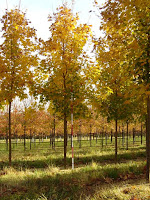Amelanchier (Serviceberry) is a great landscape plant today for many reasons. While most attributes such as North American native, great fall color, supports wildlife, etc. are widely known, one attribute - great tasting fruit, is not widely promoted. Here are quotes from other sources to support our re-positioning Amelanchier as a great addition to the "edible garden."
Dr. Michael Dirr*: "Fruit: Berry-like pome, orange-shaped, 1/4 to 1/3" diameter, changing from green to red and finally to purplish black, bloomy, slightly sweetish, and birds love them; ripens in June, actually matures over a 3-4 week period and must be picked before birds clean the plant; ripe fruits are better than highbush blueberries; I have had serviceberry pie and it ranks in the first order of desserts." *ref. Manual of Woody Landscape Plants-6th edition, Stipes Publishing.
Gurney's Seed & Nursery (2009 Catalog): "Saskatoon Blueberry - Hardy in the Far North. Not a true blueberry, but it tastes like one and doesn't need acid soil to thrive. Produces a huge July crop. Grows 15-20 feet tall. Self-pollinating. Many of the fruits are native species that grow wild in various parts of the country. They are very adaptable and generally carefree. A few are delicious when eaten fresh; others make excellent desserts and wines."
Lady Bird Johnson Wildflower Center: (Amelanchier laevis) "Very easy to grow and provides year-round interest. Berries are edible and juicier than those of the similar A. arborea. The sweet, juicy fruits are edible and rich in iron and copper. (Kershaw) Native peoples dried the small pomes like raisins or mashed and dried them in cakes. Often the dried fruits were mixed with meat and fat to form pemmican, a light-weight, high-energy food that could support winter travellers for long periods if the diet was supplemented with vitamin C to prevent scurvy. (Kershaw)"
Missouri Botanical Garden: "Edible berries are sweet, resembling blueberries in size and color, and are often used in jams, jellies and pies. Amelanchiers are also often commonly called Juneberries. Amelanchier x grandiflora is a cross between A. arborea and A. laevis."
Colorado State Univ: "Several species of serviceberry or amelanchiers are grown for fruit production. Some serviceberries are used only as landscape plants. The Saskatoon serviceberry is considered superior for fruit production. Serviceberries were used by Native Americans to make pemmican, a mainstay of their diets."
Serviceberry - a Superfruit?: When searching the internet, many sites are quoting Saskatoons (Serviceberry) as being higher in Antioxidants than Blueberries as well as providing many positive digestive benefits. Many describe them as "superfruits." Suggested search terms: "saskatoon + antioxidants." Check it out for yourself!






















